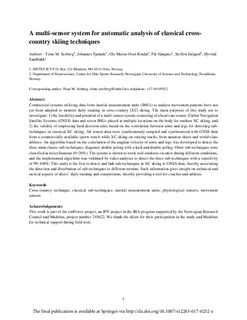| dc.contributor.author | Seeberg, Trine Margrethe | |
| dc.contributor.author | Tjønnås, Johannes | |
| dc.contributor.author | Rindal, Ole Marius Hoel | |
| dc.contributor.author | Haugnes, Pål | |
| dc.contributor.author | Dalgard, Steffen Harald | |
| dc.contributor.author | Sandbakk, Øyvind | |
| dc.date.accessioned | 2017-11-02T08:44:50Z | |
| dc.date.available | 2017-11-02T08:44:50Z | |
| dc.date.created | 2017-10-31T15:04:37Z | |
| dc.date.issued | 2017 | |
| dc.identifier.citation | Sports Engineering. 2017, pp 15 | nb_NO |
| dc.identifier.issn | 1369-7072 | |
| dc.identifier.uri | http://hdl.handle.net/11250/2463610 | |
| dc.description.abstract | Commercial systems utilizing data from inertial measurement units (IMUs) to analyse movement patterns have not yet been adapted to monitor daily training in cross-country (XC) skiing. The main purposes of this study are to investigate: (1) the feasibility and potential of a multi-sensor system consisting of a heart rate sensor, global navigation satellite systems (GNSSs) data and seven IMUs placed at multiple locations on the body for outdoor XC skiing, and (2) the validity of employing hard decision rules based on the correlation between arms and legs for detecting sub-techniques in classical XC skiing. All sensor data were synchronously sampled and synchronized with GNSS data from a commercially available sports watch while XC skiing on varying tracks, from amateur skiers and world-class athletes. An algorithm based on the correlation of the angular velocity of arms and legs was developed to detect the three main classic sub-techniques, diagonal, double poling with a kick and double poling. Other sub-techniques were classified as miscellaneous (0–20%). The system is shown to work well outdoors on snow during different conditions, and the implemented algorithm was validated by video analyses to detect the three sub-techniques with a sensitivity of 99–100%. This study is the first to detect and link sub-techniques in XC skiing to GNSS data, thereby associating the detection and distribution of sub-techniques to different terrains. Such information gives insight into the technical and tactical aspects of skiers’ daily training and competitions, thereby providing a tool for coaches and athletes. | nb_NO |
| dc.language.iso | eng | nb_NO |
| dc.rights | Attribution-NonCommercial-NoDerivatives 4.0 Internasjonal | * |
| dc.rights.uri | http://creativecommons.org/licenses/by-nc-nd/4.0/deed.no | * |
| dc.title | A multi-sensor system for automatic analysis of classical cross-country skiing techniques | nb_NO |
| dc.type | Journal article | nb_NO |
| dc.type | Peer reviewed | nb_NO |
| dc.description.version | acceptedVersion | nb_NO |
| dc.source.pagenumber | 15 | nb_NO |
| dc.source.journal | Sports Engineering | nb_NO |
| dc.identifier.doi | 10.1007/s12283-017-0252-z | |
| dc.identifier.cristin | 1509438 | |
| dc.relation.project | Norges forskningsråd: 245622 | nb_NO |
| cristin.unitcode | 7401,90,32,0 | |
| cristin.unitcode | 7401,90,23,0 | |
| cristin.unitname | Instrumentering | |
| cristin.unitname | Anvendt kybernetikk | |
| cristin.ispublished | true | |
| cristin.fulltext | postprint | |
| cristin.qualitycode | 1 | |

